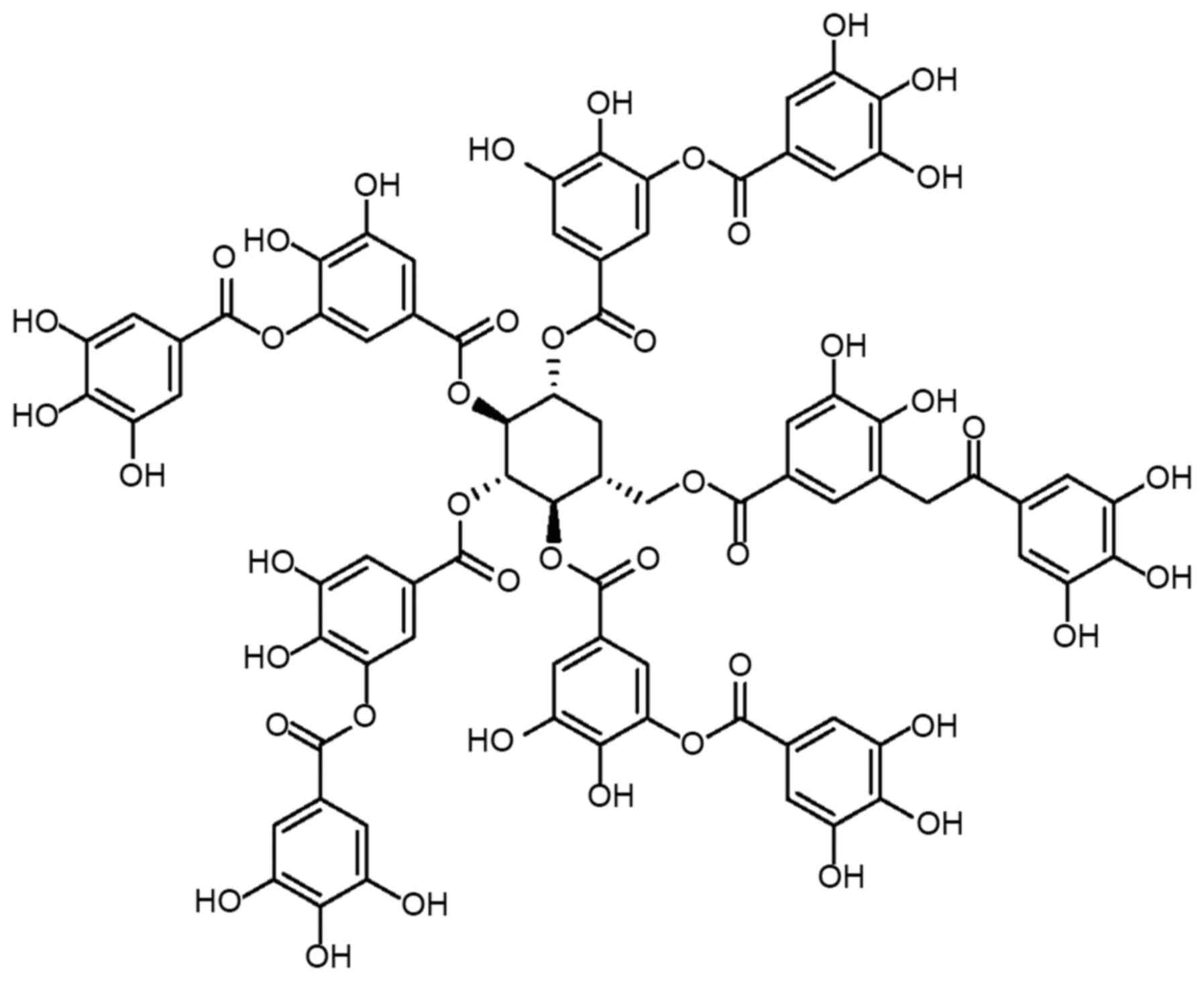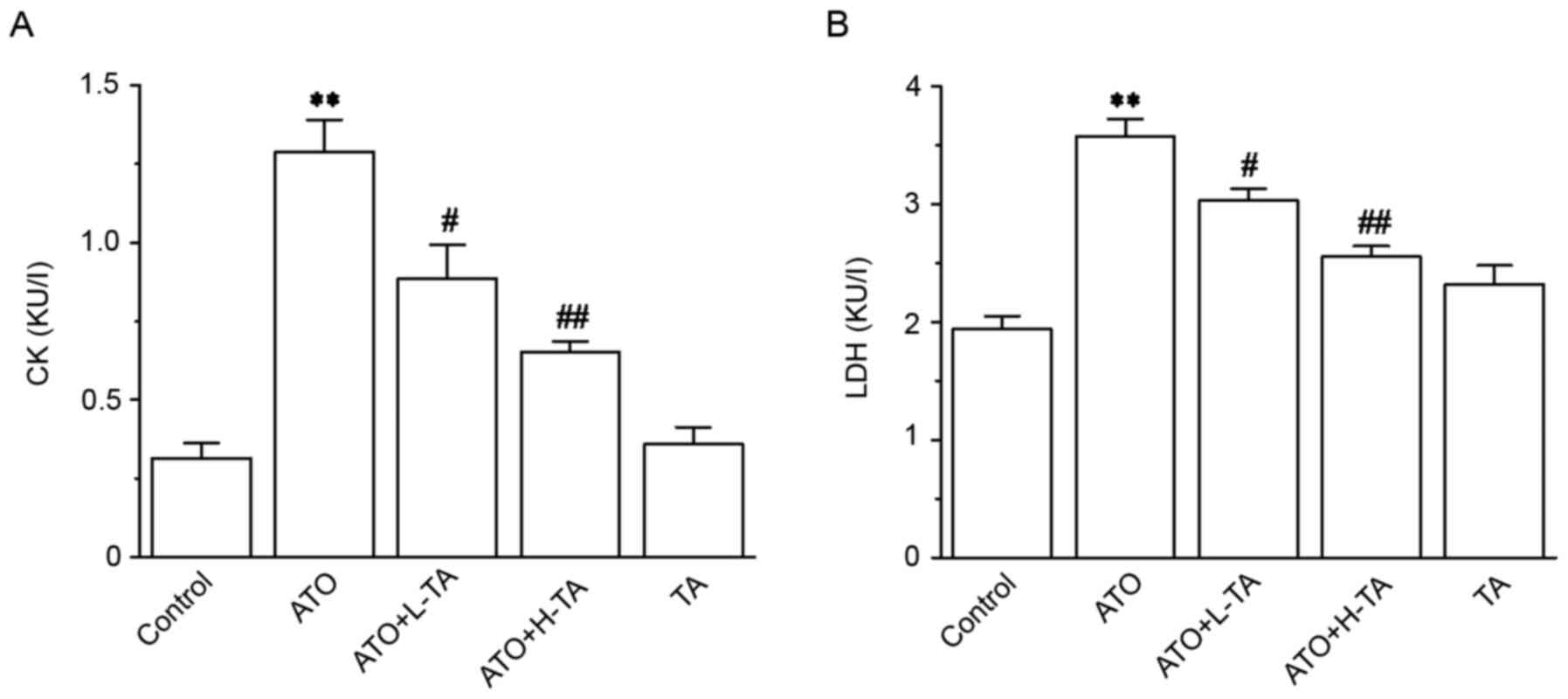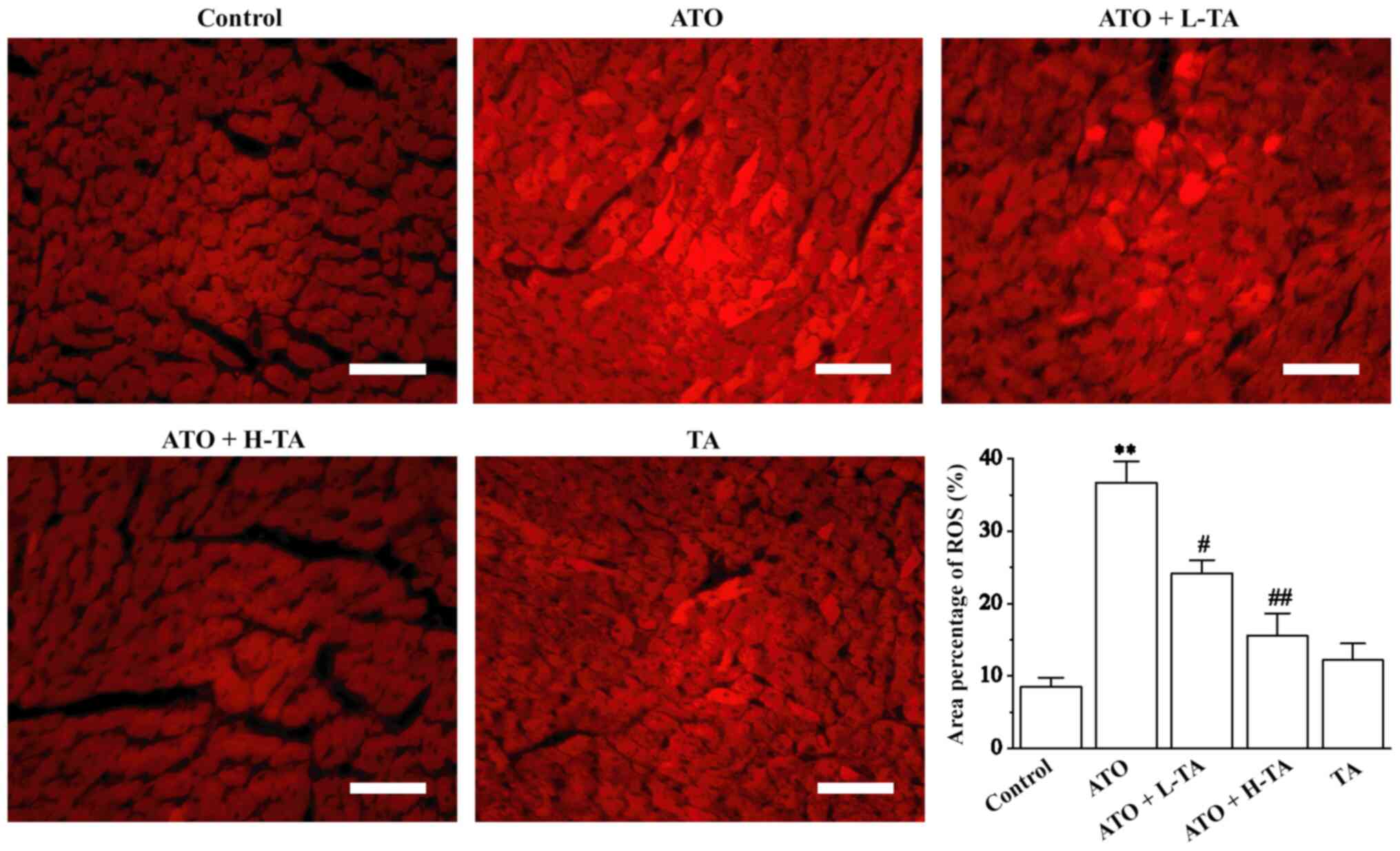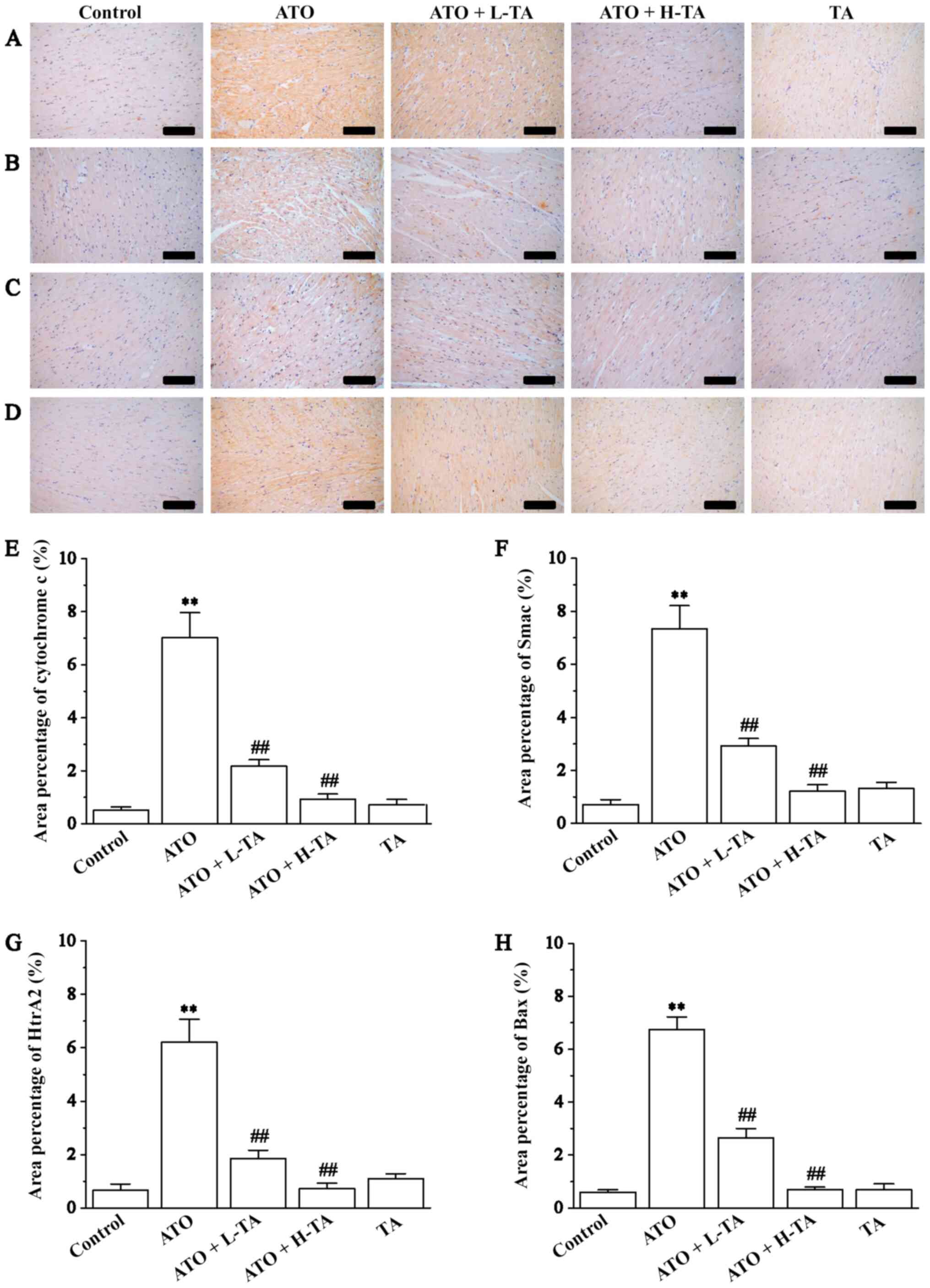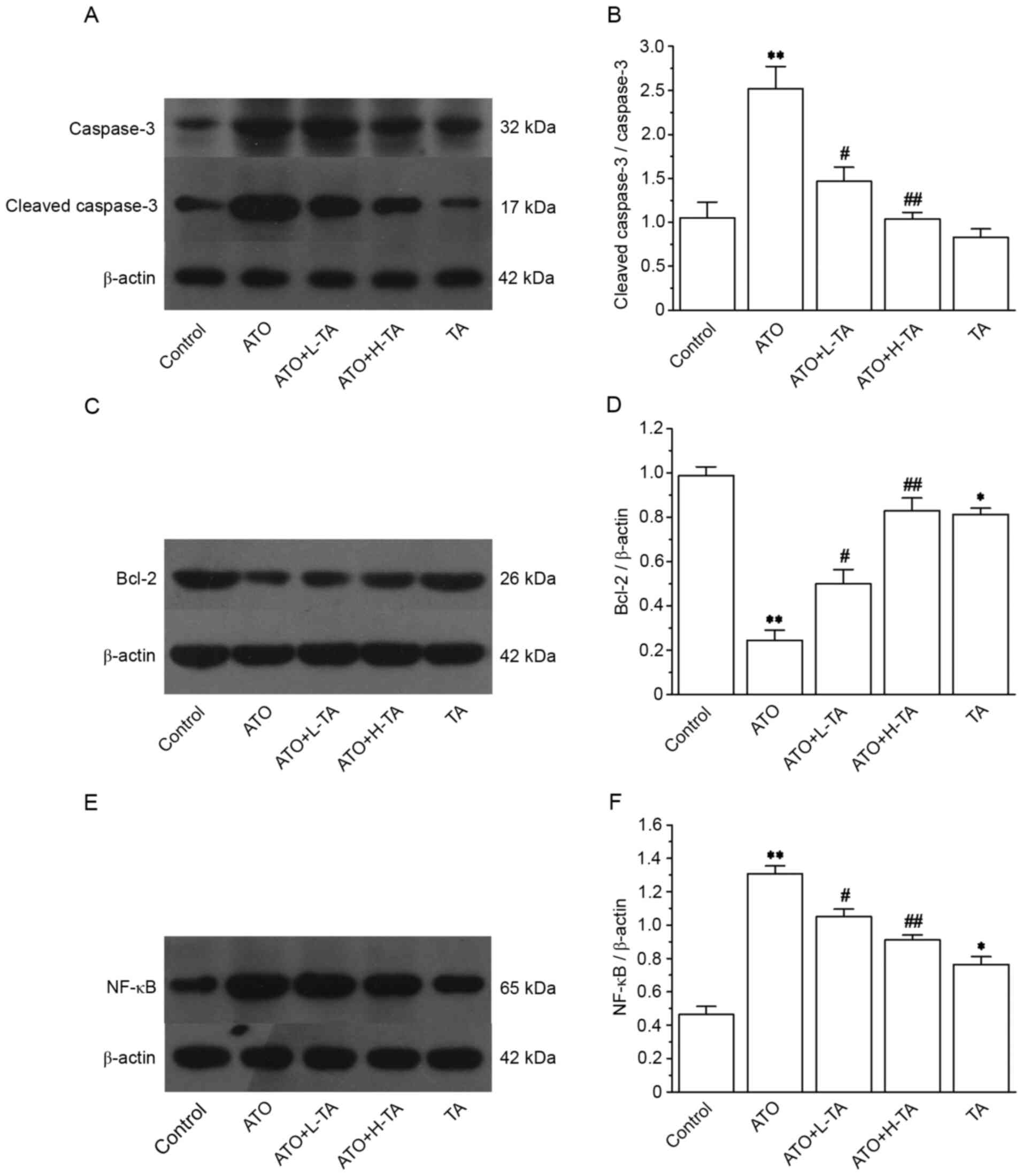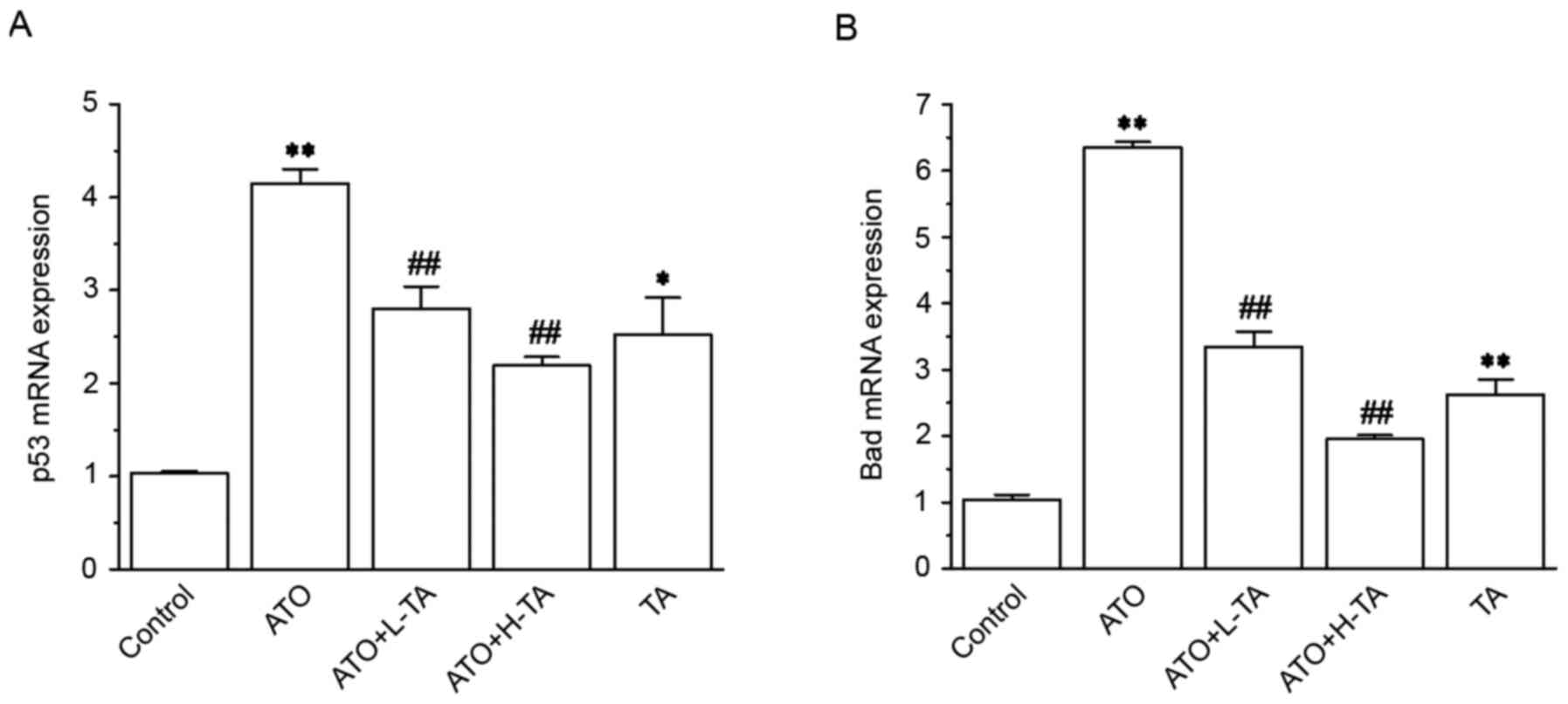|
1
|
Alamolhodaei NS, Shirani K and Karimi G:
Arsenic cardiotoxicity: An overview. Environ Toxicol Pharmacol.
40:1005–1014. 2015. View Article : Google Scholar : PubMed/NCBI
|
|
2
|
Manna P, Sinha M and Sil PC:
Arsenic-induced oxidative myocardial injury: Protective role of
arjunolic acid. Arch Toxicol. 82:137–149. 2008. View Article : Google Scholar : PubMed/NCBI
|
|
3
|
Mathews V, Chendamarai E, George B,
Viswabandya A and Srivastava A: Treatment of acute promyelocytic
leukemia with single-agent arsenic trioxide. Mediterr J Hematol
Infect. 3:e20110562011. View Article : Google Scholar
|
|
4
|
Zhang TC, Cao EH, Li JF, Ma W and Qin JF:
Induction of apoptosis and inhibition of human gastric cancer
MGC-803 cell growth by arsenic trioxide. Eur J Cancer.
35:1258–1263. 1999. View Article : Google Scholar : PubMed/NCBI
|
|
5
|
Shen ZY, Zhang Y, Chen JY, Chen MH, Shen
J, Luo WH and Zeng Y: Intratumoral injection of arsenic to enhance
antitumor efficacy in human esophageal carcinoma cell xenografts.
Oncol Rep. 11:155–159. 2004.PubMed/NCBI
|
|
6
|
Akao Y, Nakagawa Y and Akiyama K: Arsenic
trioxide induces apoptosis in neuroblastoma cell lines through the
activation of caspase 3 in vitro. FEBS Lett. 455:59–62. 1999.
View Article : Google Scholar : PubMed/NCBI
|
|
7
|
Tai S, Xu LF, Xu M, Zhang LG, Zhang YY,
Zhang KP, Zhang L and Liang CZ: Combination of arsenic trioxide and
everolimus (Rad001) synergistically induces both autophagy and
apoptosis in prostate cancer cells. Oncotarget. 8:11206–11218.
2017. View Article : Google Scholar : PubMed/NCBI
|
|
8
|
Bao ZY, Han ZB, Zhang B, Yu Y, Xu ZH, Ma
WY, Ding FZ, Zhang L, Yu MX, Liu SZ, et al: Arsenic trioxide
blocked proliferation and cardiomyocyte differentiation of human
induced pluripotent stem cells: Implication in cardiac
developmental toxicity. Toxicol Lett. 309:51–58. 2019. View Article : Google Scholar : PubMed/NCBI
|
|
9
|
Liu YS, Liang YR, Zheng B, Chu L, Ma DL,
Wang HF, Chu X and Zhang JP: Protective Effects of crocetin on
arsenic trioxide-induced hepatic injury: Involvement of suppression
in oxidative stress and inflammation through activation of Nrf2
signaling pathway in rats. Drug Des Devel Ther. 14:1921–1931. 2020.
View Article : Google Scholar : PubMed/NCBI
|
|
10
|
Unnikrishnan D, Dutcher JP, Garl S,
Varshneya N, Lucariello R and Wiernik PH: Cardiac monitoring of
patients receiving arsenic trioxide therapy. Br J Haematol.
124:610–617. 2004. View Article : Google Scholar : PubMed/NCBI
|
|
11
|
Mu MY, Zhao HJ, Wang Y, Liu JJ, Fei DX and
Xing MW: Arsenic trioxide or/and copper sulfate co-exposure induce
glandular stomach of chicken injury via destruction of the
mitochondrial dynamics and activation of apoptosis as well as
autophagy. Ecotoxicol Environ Saf. 185:1096782019. View Article : Google Scholar : PubMed/NCBI
|
|
12
|
Badarkhe GV, Sil A, Bhattacharya S, Nath
UK and Das NK: Erythema multiforme due to arsenic trioxide in a
case of acute promyelocytic leukemia: A diagnostic challenge.
Indian J Pharmacol. 48:216–218. 2016. View Article : Google Scholar : PubMed/NCBI
|
|
13
|
Roboz GJ, Ritchie EK, Carlin RF, Samuel M,
Gale L, Provenzano-Gober JL, Curcio TJ, Feldman EJ and Kligfield
PD: Prevalence, management, and clinical consequences of QT
interval prolongation during treatment with arsenic trioxide. J
Clin Oncol. 32:3723–3728. 2014. View Article : Google Scholar : PubMed/NCBI
|
|
14
|
Hai JJ, Gill H, Tse HF, Kumana CR, Kwong
YL and Siu CW: Torsade de pointes during oral arsenic trioxide
therapy for acute promyelocytic leukemia in a patient with heart
failure. Ann Hematol. 94:501–503. 2015. View Article : Google Scholar : PubMed/NCBI
|
|
15
|
Zhang Y, Wei ZK, Liu WJ, Wang JJ, He XX,
Huang HL, Zhang JL and Yang ZT: Melatonin protects against arsenic
trioxide-induced liver injury by the upregulation of Nrf2
expression through the activation of PI3K/AKT pathway. Oncotarget.
8:3773–3780. 2017. View Article : Google Scholar : PubMed/NCBI
|
|
16
|
Wang XN, Zhao HY, Shao YL, Wang P, Wei YR,
Zhang WQ, Jiang J, Chen Y and Zhang Z: Nephroprotective effect of
astaxanthin against trivalent inorganic arsenic-induced renal
injury in wistar rats. Nutr Res Pract. 8:46–53. 2014. View Article : Google Scholar : PubMed/NCBI
|
|
17
|
Cheng Y, Xue J, Jiang H, Wang M, Gao L, Ma
D and Zhang Z: Neuroprotective effect of resveratrol on arsenic
trioxide-induced oxidative stress in feline brain. Hum Exp Toxicol.
33:737–747. 2014. View Article : Google Scholar : PubMed/NCBI
|
|
18
|
Ahamed M, Akhtar MJ and Alhadlaq HA:
Co-exposure to SiO2 nanoparticles and arsenic induced
augmentation of oxidative stress and mitochondria-dependent
apoptosis in human cells. Int J Environ Res Public Health.
16:31992019. View Article : Google Scholar
|
|
19
|
Sabbah HN: Targeting the mitochondria in
heart failure: A translational perspective. JACC Basic Transl Sci.
5:88–106. 2020. View Article : Google Scholar : PubMed/NCBI
|
|
20
|
Chistiakov DA, Shkurat TP, Melnichenko AA,
Grechko AV and Orekhov AN: The role of mitochondrial dysfunction in
cardiovascular disease: A brief review. Ann Med. 50:121–127. 2018.
View Article : Google Scholar : PubMed/NCBI
|
|
21
|
Roy D, Felty Q, Narayan S and Jayakar P:
Signature of mitochondria of steroidal hormones-dependent normal
and cancer cells: Potential molecular targets for cancer therapy.
Front Biosci. 12:154–173. 2007. View
Article : Google Scholar : PubMed/NCBI
|
|
22
|
Brown DA, Perry JB, Allen ME, Sabbah HN,
Stauffer BL, Shaikh SR, Cleland JG, Colucci WS, Butler J, Voors AA,
et al: Expert consensus document: Mitochondrial function as a
therapeutic target in heart failure. Nat Rev Cardiol. 14:238–250.
2017. View Article : Google Scholar : PubMed/NCBI
|
|
23
|
Pohjoismäki JL and Goffart S: The role of
mitochondria in cardiac development and protection. Free Radic Biol
Med. 106:345–354. 2017. View Article : Google Scholar : PubMed/NCBI
|
|
24
|
Peoples JN, Saraf A, Ghazal N, Pham TT and
Kwong JQ: Mitochondrial dysfunction and oxidative stress in heart
disease. Exp Mol Med. 51:1–13. 2019. View Article : Google Scholar : PubMed/NCBI
|
|
25
|
Abdelrahman RS, El-Awady MS, Nader MA and
Ammar EM: Hydrogen sulfide ameliorates cardiovascular dysfunction
induced by cecal ligation and puncture in rats. Hum Exp Toxicol.
34:953–964. 2015. View Article : Google Scholar : PubMed/NCBI
|
|
26
|
Gill C, Mestril R and Samali A: Losing
heart: The role of apoptosis in heart disease-a novel therapeutic
target? FASEB J. 16:135–146. 2002. View Article : Google Scholar : PubMed/NCBI
|
|
27
|
Yu XJ, Wang ZY, Shu ZP, Li ZQ, Ning Y, Yun
KL, Bai HN, Liu RH and Liu WL: Effect and mechanism of Sorbus
pohuashanensis (Hante) Hedl. Flavonoids protect against arsenic
trioxide-induced cardiotoxicity. Biomed Pharmacother. 88:1–10.
2017. View Article : Google Scholar : PubMed/NCBI
|
|
28
|
McDonough KH: The role of alcohol in the
oxidant antioxidant balance in heart. Front Biosci. 4:D601–D606.
1999. View Article : Google Scholar : PubMed/NCBI
|
|
29
|
Wang Y, Wu YP, Wang YY, Xu H, Mei XQ, Yu
DY, Wang YB and Li WF: Antioxidant properties of probiotic
bacteria. Nutrients. 9:5212017. View Article : Google Scholar
|
|
30
|
Vineetha VP, Soumya RS and Raghu KG:
Phloretin ameliorates arsenic trioxide induced mitochondrial
dysfunction in H9c2 cardiomyoblasts mediated via alterations in
membrane permeability and ETC complexes. Eur J Pharmacol.
754:162–172. 2015. View Article : Google Scholar : PubMed/NCBI
|
|
31
|
Lindskog M, Gleissman H, Ponthan F, Castro
J, Kogner P and Johnsen JI: Neuroblastoma cell death in response to
docosahexaenoic acid: Sensitization to chemotherapy and
arsenic-induced oxidative stress. Int J Cancer. 118:2584–2593.
2006. View Article : Google Scholar : PubMed/NCBI
|
|
32
|
Chen H, Liu G, Qiao N, Kang Z, Hu L, Liao
J, Yang F, Pang C, Liu B, Zeng Q, et al: Toxic effects of arsenic
trioxide on spermatogonia are associated with oxidative stress,
mitochondrial dysfunction, autophagy and metabolomic alterations.
Ecotoxicol Environ Saf. 190:1100632020. View Article : Google Scholar : PubMed/NCBI
|
|
33
|
Patlolla AK and Tchounwou PB: Serum acetyl
cholinesterase as a biomarker of arsenic induced neurotoxicity in
sprague-dawley rats. Int J Environ Res Public Health. 2:80–83.
2005. View Article : Google Scholar : PubMed/NCBI
|
|
34
|
Vineetha VP and Raghu KG: An overview on
arsenic trioxide-induced cardiotoxicity. Cardiovasc Toxicol.
19:105–119. 2019. View Article : Google Scholar : PubMed/NCBI
|
|
35
|
Amini-Khoei H, Hosseini MJ, Momeny M,
Rahimi-Balaei M, Amiri S, Haj-Mirzaian A, Khedri M, Jahanabadi S,
Mohammadi-Asl A, Mehr SE and Dehpour AR: Morphine attenuated the
cytotoxicity induced by arsenic trioxide in H9c2 cardiomyocytes.
Biol Trace Elem Res. 173:132–139. 2016. View Article : Google Scholar : PubMed/NCBI
|
|
36
|
Ghosh J, Das J, Manna P and Sil PC:
Taurine prevents arsenic-induced cardiac oxidative stress and
apoptotic damage: Role of NF-kappa B, p38 and JNK MAPK pathway.
Toxicol Appl Pharmacol. 240:73–87. 2009. View Article : Google Scholar : PubMed/NCBI
|
|
37
|
Zhang JY, Sun GB, Luo Y, Wang M, Wang W,
Du YY, Yu YL and Sun XB: Salvianolic acid a protects H9c2 cells
from arsenic trioxide-induced injury via inhibition of the MAPK
signaling pathway. Cell Physiol Biochem. 41:1957–1969. 2017.
View Article : Google Scholar : PubMed/NCBI
|
|
38
|
Zhu S, Wang Y, Liu H, Wei W, Tu Y, Chen C,
Song J, Xu Z, Li J, Wang C and Sun S: Thyroxine affects
lipopolysaccharide-induced macrophage differentiation and
myocardial cell apoptosis via the NF-κB p65 pathway both in vitro
and in vivo. Mediators Inflamm. 2019:20989722019. View Article : Google Scholar : PubMed/NCBI
|
|
39
|
Liu X, Kim J, Li Y, Li J, Liu F and Chen
X: Tannic acid stimulates glucose transport and inhibits adipocyte
differentiation in 3T3-L1 cells. J Nutr. 135:165–171. 2005.
View Article : Google Scholar : PubMed/NCBI
|
|
40
|
Hemmati AA, Olapour S, Varzi HN, Khodayar
MJ, Dianat M, Mohammadian B and Yaghooti H: Ellagic acid protects
against arsenic trioxide-induced cardiotoxicity in rat. Hum Exp
Toxicol. 37:412–419. 2018. View Article : Google Scholar : PubMed/NCBI
|
|
41
|
Ashafaq M, Sharma P, Khatoon S, Haque D,
Tabassum H and Parvez S: Heavy metal-induced systemic dysfunction
attenuated by tannic acid. J Environ Pathol Toxicol Oncol.
35:109–120. 2016. View Article : Google Scholar : PubMed/NCBI
|
|
42
|
Zhang JP, Cui LJ, Han X, Zhang YY, Zhang
X, Chu X, Zhang FH, Zhang Y and Chu L: Protective effects of tannic
acid on acute doxorubicin-induced cardiotoxicity: Involvement of
suppression in oxidative stress, inflammation, and apoptosis.
Biomed Pharmacother. 93:1253–1260. 2017. View Article : Google Scholar : PubMed/NCBI
|
|
43
|
Chu L, Li PY, Song T, Han X, Zhang X, Song
QT, Liu T, Zhang YY and Zhang JP: Protective effects of tannic acid
on pressure overload-induced cardiac hypertrophy and underlying
mechanisms in rats. J Pharm Pharmacol. 69:1191–1207. 2017.
View Article : Google Scholar : PubMed/NCBI
|
|
44
|
Zhu FL, Chu X, Wang H, Zhang X, Zhang YY,
Liu ZY, Guo H, Liu HY, Liu Y, Chu L and Zhang JP: New Findings on
the effects of tannic acid: Inhibition of L-Type calcium channels,
Calcium transient and contractility in rat ventricular myocytes.
Phytother Res. 30:510–516. 2016. View Article : Google Scholar : PubMed/NCBI
|
|
45
|
Jin WY, Xue YR, Xue YC, Han X, Song QT,
Zhang JP, Li ZL, Cheng J, Guan SJ, Sun SJ and Chu L: Tannic acid
ameliorates arsenic trioxide-induced nephrotoxicity, contribution
of NF-κB and Nrf2 pathways. Biomed Pharmacother. 126:1100472020.
View Article : Google Scholar : PubMed/NCBI
|
|
46
|
Kumazaki M, Ando H, Sasaki A, Koshimizu
TA, Ushijima K, Hosohata K, Oshima Y and Fujimura A: Protective
effect of α-lipoic acid against arsenic trioxide-induced acute
cardiac toxicity in rats. J Pharmacol Sci. 115:244–248. 2011.
View Article : Google Scholar
|
|
47
|
Miao X, Tang ZF, Wang YG, Su GF, Sun WX,
Wei W, Li W, Miao LN, Cai L, Tan Y and Liu QJ: Metallothionein
prevention of arsenic trioxide-induced cardiac cell death is
associated with its inhibition of mitogen-activated protein kinases
activation in vitro and in vivo. Toxicol Lett. 220:277–285. 2013.
View Article : Google Scholar : PubMed/NCBI
|
|
48
|
Saxena PN, Anand S, Saxena N and Bajaj P:
Effect of arsenic trioxide on renal functions and its modulation by
curcuma aromatica leaf extract in albino rat. J Environ Biol.
30:527–531. 2009.PubMed/NCBI
|
|
49
|
Liu J, Lu Y, Wu Q, Goyer RA and Waalkes
MP: Mineral arsenicals in traditional medicines: Orpiment, realgar,
and arsenolite. J Pharmacol Exp Ther. 326:363–368. 2008. View Article : Google Scholar : PubMed/NCBI
|
|
50
|
Song J, Ding WB, Liu BJ, Liu D, Xia Z,
Zhang L, Cui L, Luo Y, Jia XB and Feng L: Anticancer effect of
caudatin in diethylnitrosamine-induced hepatocarcinogenesis in
rats. Mol Med Rep. 22:697–706. 2020. View Article : Google Scholar : PubMed/NCBI
|
|
51
|
Livak KJ and Schmittgen TD: Analysis of
relative gene expression data using real-time quantitative PCR and
the 2(-Delta Delta C(T)) method. Methods. 25:402–408. 2001.
View Article : Google Scholar : PubMed/NCBI
|
|
52
|
Costa VM, Carvalho F, Duarte JA, Bastos
Mde L and Remiao F: The heart as a target for xenobiotic toxicity:
The cardiac susceptibility to oxidative stress. Chem Res Toxicol.
26:1285–1311. 2013. View Article : Google Scholar : PubMed/NCBI
|
|
53
|
James TN: Long reflections on the QT
interval: The sixth annual Gordon K. Moe Lecture. J Cardiovasc
Electrophysiol. 7:738–759. 1996. View Article : Google Scholar : PubMed/NCBI
|
|
54
|
Best PJ, Hasdai D, Sangiorgi G, Schwartz
RS, Holmes DR Jr, Simari RD and Lerman A: Apoptosis. Basic concepts
and implications in coronary artery disease. Arterioscler Thromb
Vasc Biol. 19:14–22. 1999. View Article : Google Scholar : PubMed/NCBI
|
|
55
|
Matsui M, Nishigori C, Toyokuni S, Takada
J, Akaboshi M, Ishikawa M, Imamura S and Miyachi Y: The role of
oxidative DNA damage in human arsenic carcinogenesis: Detection of
8-hydroxy-2′-deoxyguanosine in arsenic-related Bowen's disease. J
Invest Dermatol. 113:26–31. 1999. View Article : Google Scholar : PubMed/NCBI
|
|
56
|
Berridge MJ, Lipp P and Bootman MD: The
versatility and universality of calcium signalling. Nat Rev Mol
Cell Biol. 1:11–21. 2000. View Article : Google Scholar : PubMed/NCBI
|
|
57
|
Pulido MD and Parrish AR: Metal-induced
apoptosis: Mechanisms. Mutat Res. 533:227–241. 2003. View Article : Google Scholar : PubMed/NCBI
|
|
58
|
Torka P, Al Ustwani O, Wetzler M, Wang ES
and Griffiths EA: Swallowing a bitter pill-oral arsenic trioxide
for acute promyelocytic leukemia. Blood Rev. 30:201–211. 2016.
View Article : Google Scholar : PubMed/NCBI
|
|
59
|
Sugden PH and Clerk A: Oxidative stress
and growth-regulating intracellular signaling pathways in cardiac
myocytes. Antioxid Redox Signal. 8:2111–2124. 2006. View Article : Google Scholar : PubMed/NCBI
|
|
60
|
Vineetha RC, Binu P, Arathi P and Nair RH:
L-ascorbic acid and alpha-tocopherol attenuate arsenic
trioxide-induced toxicity in H9c2 cardiomyocytes by the activation
of Nrf2 and Bcl2 transcription factors. Toxicol Mech Methods.
28:353–360. 2018. View Article : Google Scholar : PubMed/NCBI
|
|
61
|
Petit PX, Susin SA, Zamzami N, Mignotte B
and Kroemer G: Mitochondria and programmed cell death: Back to the
future. FEBS Lett. 396:7–13. 1996. View Article : Google Scholar : PubMed/NCBI
|
|
62
|
Lopez J and Tait SW: Mitochondrial
apoptosis: Killing cancer using the enemy within. Br J Cancer.
112:957–962. 2015. View Article : Google Scholar : PubMed/NCBI
|
|
63
|
Naoi M, Wu Y, Shamoto-Nagai M and Maruyama
W: Mitochondria in neuroprotection by phytochemicals: Bioactive
polyphenols modulate mitochondrial apoptosis system, function and
structure. Int J Mol Sci. 20:24512019. View Article : Google Scholar
|
|
64
|
Teixeira J, Deus CM, Borges F and Oliveira
PJ: Mitochondria: Targeting mitochondrial reactive oxygen species
with mitochondriotropic polyphenolic-based antioxidants. Int J
Biochem Cell Biol. 97:98–103. 2018. View Article : Google Scholar : PubMed/NCBI
|
|
65
|
Wang C, Zhang X, Teng ZP, Zhang T and Li
Y: Downregulation of PI3K/Akt/mTOR signaling pathway in
curcumin-induced autophagy in APP/PS1 double transgenic mice. Eur J
Pharmacol. 740:312–320. 2014. View Article : Google Scholar : PubMed/NCBI
|
|
66
|
Tower J: Programmed cell death in aging.
Ageing Res Rev. 23:90–100. 2015. View Article : Google Scholar : PubMed/NCBI
|
|
67
|
Moloudi K, Neshasteriz A, Hosseini A,
Eyvazzadeh N, Shomali M, Eynali S, Mirzaei E and Azarnezhad A:
Synergistic Effects of arsenic trioxide and radiation: Triggering
the intrinsic pathway of apoptosis. Iran Biomed J. 21:330–337.
2017. View Article : Google Scholar : PubMed/NCBI
|
|
68
|
Adil M, Kandhare AD, Ghosh P and Bodhankar
SL: Sodium arsenite-induced myocardial bruise in rats: Ameliorative
effect of naringin via TGF-β/Smad and Nrf/HO pathways. Chem Biol
Interact. 253:66–77. 2016. View Article : Google Scholar : PubMed/NCBI
|
|
69
|
Estaquier J, Vallette F, Vayssiere JL and
Mignotte B: The mitochondrial pathways of apoptosis. Adv Exp Med
Biol. 942:157–183. 2012. View Article : Google Scholar : PubMed/NCBI
|
|
70
|
Du CY, Fang M, Li YC, Lily L and Wang XD:
Smac, a mitochondrial protein that promotes cytochrome c-dependent
caspase activation by eliminating IAP inhibition. Cell. 102:33–42.
2000. View Article : Google Scholar : PubMed/NCBI
|
|
71
|
Boise LH, Gottschalk AR, Quintáns J and
Thompson CB: Bcl-2 and Bcl-2-related proteins in apoptosis
regulation. Curr Top Microbiol Immunol. 200:107–121.
1995.PubMed/NCBI
|
|
72
|
Tischner D, Woess C, Ottina E and
Villunger A: Bcl-2-regulated cell death signalling in the
prevention of autoimmunity. Cell Death Dis. 1:e482010. View Article : Google Scholar : PubMed/NCBI
|
|
73
|
Miyashita T and Reed JC: Tumor suppressor
p53 is a direct transcriptional activator of the human bax gene.
Cell. 80:293–299. 1995. View Article : Google Scholar : PubMed/NCBI
|
|
74
|
Oda E, Ohki R, Murasawa H, Nemoto J,
Shibue T, Yamashita T, Tokino T, Taniguchi T and Tanaka N: Noxa, a
BH3-only member of the Bcl-2 family and candidate mediator of
p53-induced apoptosis. Science. 288:1053–1058. 2000. View Article : Google Scholar : PubMed/NCBI
|
|
75
|
Shen Y and Shenk T: Relief of p53-mediated
transcriptional repression by the adenovirus E1B 19-kDa protein or
the cellular Bcl-2 protein. Proc Natl Acad Sci USA. 91:8940–8944.
1994. View Article : Google Scholar : PubMed/NCBI
|
|
76
|
Hoffman WH, Biade S, Zilfou JT, Chen J and
Murphy M: Transcriptional repression of the anti-apoptotic survivin
gene by wild type p53. J Biol Chem. 277:3247–3257. 2002. View Article : Google Scholar : PubMed/NCBI
|
|
77
|
Bensaad K and Vousden KH: p53: New roles
in metabolism. Trends Cell Biol. 17:286–291. 2007. View Article : Google Scholar : PubMed/NCBI
|
|
78
|
Mathas S, Lietz A, Janz M, Hinz M, Jundt
F, Scheidereit C, Bommert K and Dorken B: Inhibition of NF-kappaB
essentially contributes to arsenic-induced apoptosis. Blood.
102:1028–1034. 2003. View Article : Google Scholar : PubMed/NCBI
|
|
79
|
Pahl HL: Activators and target genes of
Rel/NF-kappaB transcription factors. Oncogene. 18:6853–6866. 1999.
View Article : Google Scholar : PubMed/NCBI
|
|
80
|
Pace C, Dagda R and Angermann J:
Antioxidants protect against arsenic induced mitochondrial
cardio-toxicity. Toxics. 5:382017. View Article : Google Scholar
|
|
81
|
Geng NN, Zheng X, Wu MS, Yang L, Li XY and
Chen JD: Tannic acid synergistically enhances the anticancer
efficacy of cisplatin on liver cancer cells through
mitochondria-mediated apoptosis. Oncol Rep. 42:2108–2116.
2019.PubMed/NCBI
|















